#sea kayak
Explore tagged Tumblr posts
Text

#studland bay#old harry rocks#dorset#weymouth#original photographers#photographers on tumblr#landscape#nature#england#britain#water#adventure#kayak#sea kayak#sunshine#summer#white cliffs
33 notes
·
View notes
Text


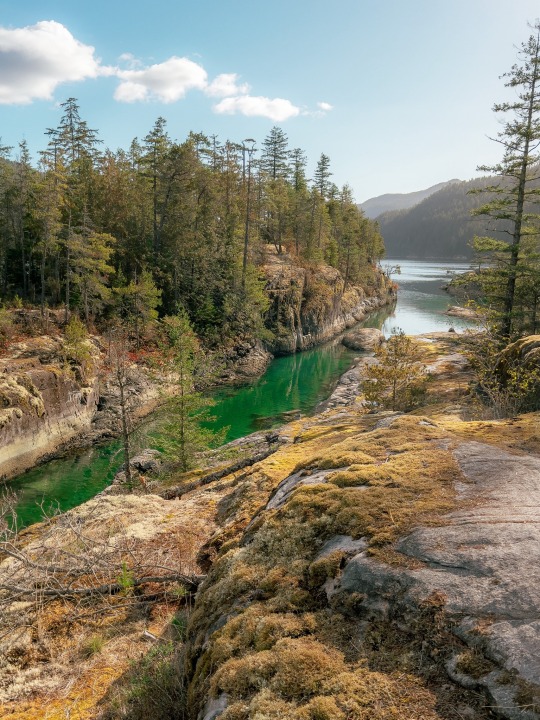
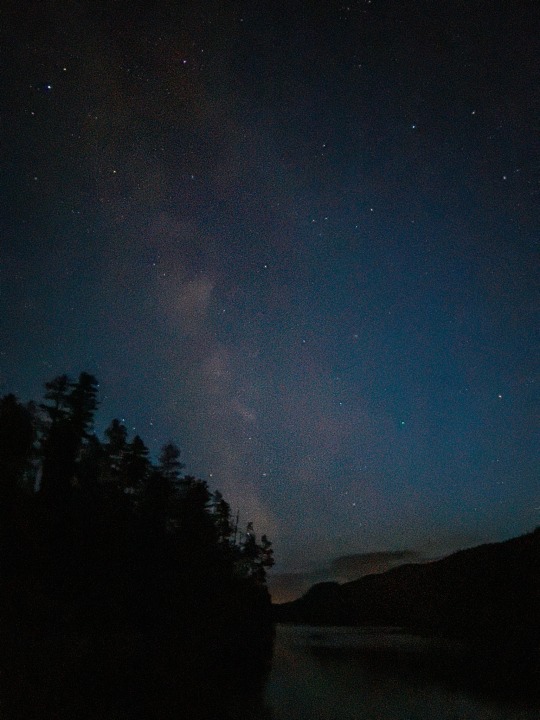



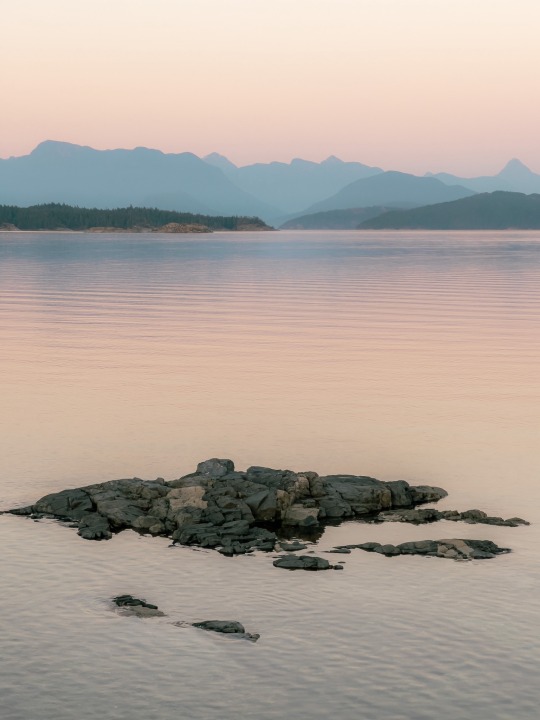
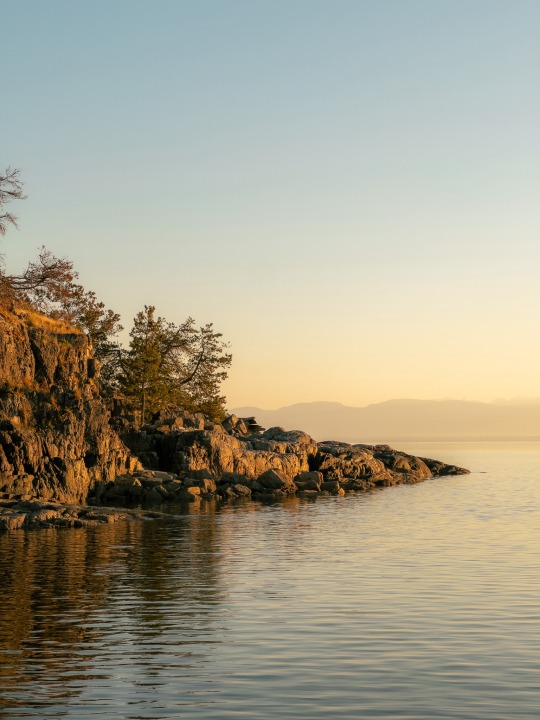

Kayak trip part 2: the paddlin
See the next post for route
#british columbia#bc#canada#mountain#forest#mountains#pnw#kayaking#sea kayak#ocean#coastal#jellyfish#camping#backpacking
15 notes
·
View notes
Text
How to Customize Your Sea Kayak

Customizing your sea kayak can beautify consolation, overall performance, and typical entertainment on the water. With diverse modifications to be had, from storage upgrades to seating adjustments, you could make your kayak private in shape for any water journey. This guide will walk you through important customization tips to help you optimize your kayak experience.
Why Customize Your Sea Kayak?
Customizations aren't just about aesthetics; they can make a big difference in how a kayak performs in different water conditions. Here are some key reasons for customizing:
Comfort: Personalized seating and foot placement can reduce fatigue on long paddles.
Storage: Adding compartments or gear holders allows you to carry essentials more efficiently.
Performance: Minor tweaks can improve speed, manoeuvrability, and stability.
Understanding Different Kayak Types
Before diving into customizations, it’s helpful to know the fundamentals of popular kayak sorts. Different kayaks fit diverse water conditions and sports, so customizing according to the kayak type will help maximize its potential.
1. Best Youth Kayaks
Best Youth kayaks are shorter, lighter, and typically more solid, making them perfect for younger paddlers or those just starting. Customizations for young people kayak usually focus on protection, consolation, and ease of control.
2. Surfski Kayaks
Surfski kayaks are designed for speed, commonly in open water. They are long, slender, and have an open cockpit. Customizations right here can enhance performance, consisting of adjusting the foot pedals for higher manipulation or including a backrest for extended consolation throughout lengthy-distance paddling.
3. Touring Kayaks
Touring kayaks are intended for longer journeys on lakes, rivers, and coastal waters. They offer excellent stability and tracking, with a focus on storage and comfort. Customizations for touring kayaks often include extra storage, cockpit padding, and upgraded rudder systems.
Essential Customization Tips
1. Improve Comfort with Custom Seats and Padding
An appropriate seat is important for any kayak, particularly in case you plan on lengthy journeys. Many sea kayaks include preferred seats that can lack sufficient padding or adjustability. Here’s what you can do to make your kayak seat more comfortable:
Replace the Seat: Look for ergonomic seats with extra padding, lumbar guides, and backrests.
Add Seat Cushions: High-pleasant gel or foam cushions can add comfort for lengthy paddles and take in shock from waves.
Install Adjustable Seat Pads: Adjustable padding helps you to customize the height and perspective for higher posture and luxury.
Comfortable seating not only reduces fatigue but also allows maneuvering and stability at the water.
2. Add a Rudder or Skeg System for Better Tracking
Tracking has the potential to hold a straight line in open water, which may be difficult in windy or uneven situations. Rudder and skeg structures can significantly enhance tracking and manipulation.
Rudder System: Controlled with the aid of foot pedals, rudders help steer the kayak, making them useful in windy conditions or strong currents. You can locate rudder kits that suit maximum sea kayaks, specifically visiting and surf ski models.
Skeg System: A skeg is a fin that drops down from the hull, presenting balance without steerage. It’s best for open water paddling in which you want to maintain a straight direction.
3. Upgrade Your Foot Braces and Pedals
Proper foot placement is vital for stability and control. Many kayaks come with fixed foot braces, which won't fit everybody’s length or desire. Consider upgrading your foot braces or pedals to provide more comfort and control.
Adjustable Foot Braces: Allows you to find the perfect foot position for better posture and comfort.
Ergonomic Foot Pedals: Some pedals are designed for maximum grip and support, making paddling more efficient.
4. Install Extra Storage Solutions
Sea kayaks often lack sufficient storage for long trips or overnight adventures. You can add various storage options to increase capacity:
Dry Bags and Hatches: Install additional hatches or use waterproof dry bags to keep your essentials safe and organized.
Deck Storage: Bungee cords on the deck can secure gear within easy reach. You can add more bungee cords or upgrade to adjustable straps.
Under-Deck Bags: Small bags that attach under the deck provide extra storage for items like snacks, maps, and sunscreen.
5. Add a Spray Skirt for Protection
Spray skirts help keep water out of the cockpit, essential for open water paddling or rough conditions. They also add a layer of insulation in cooler weather. Look for spray skirts that fit your kayak model and materials that match your climate needs.
Neoprene Skirts: Ideal for cold conditions; offers excellent insulation and water resistance.
Nylon Skirts: lightweight and breathable; incredible for hotter weather but less insulated than Neoprene.
6. Enhance Safety with Reflective Gear and Lights
Visibility is essential, specifically if you’re kayaking at dawn, nightfall, or in regions with boat visitors. Adding reflective gear or lighting can improve your protection on the water.
Reflective Tape: Apply reflective tape for your kayak’s hull, paddle, or lifestyle jacket for accelerated visibility.
Portable LED Lights: Waterproof LED lighting may be attached in your kayak for additional visibility in low-mild situations.
7. Add a Bilge Pump and Sponge for Efficient Water Management
Even with a sprig skirt, a little water might also enter your kayak throughout paddling. A bilge pump and sponge are vital equipment to hold the cockpit dry and improve consolation.
Bilge Pump: Manual pumps let you cast off water quickly from the cockpit.
Sponge: Use a sponge to soak up smaller amounts of water, specifically beneficial for preserving a dry seat.
Customization Tips for Different Kayak Types
Each kayak type benefits from specific customizations, as their use and design vary.
Youth Kayaks: Focus on adding comfortable seating, adjustable foot braces, and simple storage options to keep essentials handy.
Surfski Kayaks: Since speed is key, consider lightweight customizations that don’t add drag. Rudder systems, streamlined storage, and minimal seating adjustments work best.
Touring Kayaks: Look into additional storage compartments, high-quality padding, and durable spray skirts to support long trips.
Final Thoughts
Customizing your sea kayak can make a significant difference in overall performance, consolation, and safety. Whether it’s improving seating, adding a garage, or putting in monitoring systems, these small adjustments can help you create a kayak that fits your wishes flawlessly. So, make an effort to not forget what will make a while at the water more enjoyable and begin customizing for the ultimate kayaking revel in!
0 notes
Text
ds9 is like. i want to go home. can't go home. i want to be among my people. i cannot abide and am sickened by the actions of my people. i am completely alone. this station is too crowded. anyway have i told you about my homeplanet
#garak#odo#worf#obrien#ds9#sisko#like they name all the runabouts after earth rivers#obrien goes kayaking and sings old sea shanties tells union stories from ireland#not one person has a normal relationship with their homeplanet#most don't ever go home but this station will never BE home#at least not all the way#anyway
2K notes
·
View notes
Text

blaire snaps
#fujifilm#fuji#fujixseries#photography#new zealand#photographers of tumblr#summer#travel#lake#sea#cliff jumping#kayak
157 notes
·
View notes
Text
Mesmerizing Nature 🌅⛵🌊 !.
#Mood#kayaking#Kayak#Magic#life#downfall#downfalldestiny#حياة#magic destinations#magical world#magic moments#Breathe#Lake#Sea#Ocean#Calm#Swim#Sky
76 notes
·
View notes
Note
not a desert technically but I just visited the dunes in Monterey and gleefully trampled on some ice plant and I feel like you might enjoy that. if you wanna talk about the kinds of vegetation that grow in sandy soil or something I invite you to 👀
(also you're doing it! you're surviving! you'll get through that doctorate!)
ok ready this is my most important soapbox of all because soils in the desert are very special and have such cool organisms you don't find in these arrangements outside of drylands...
first lookee here. wauw beautiful utah

ok now look closer
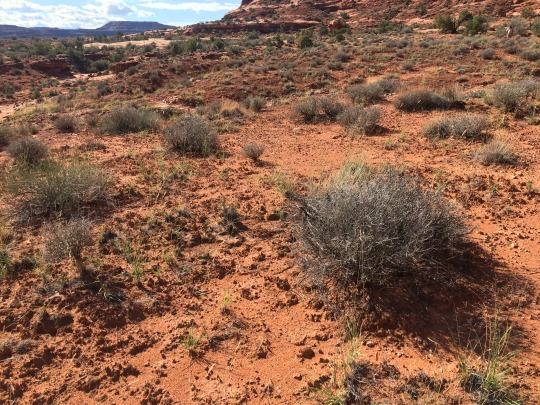
no closer closer closer
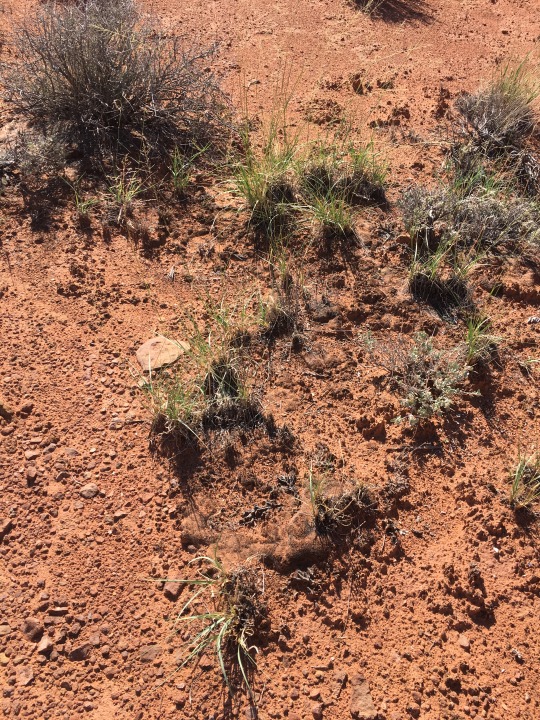
CLOSER CLOSER CLOSER
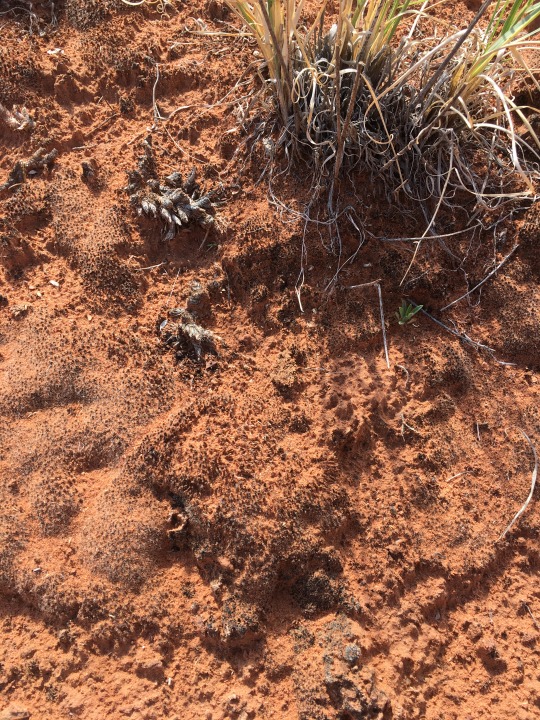
WOW is that MOSS? you are thinking. the answer is YES. but doesn't moss like lots of water you are thinking??? WELL USUALLY. BUT in the desert you will notice that things like grasses and shrubs have lots of space between them unlike in more temperate climates-vegetation cover is not truly continuous. And there's less leaf litter than in forests obscuring the dirt. Which means all that soil is just sitting out in the open with nothing to protect it from being blown away by those harsh desert winds... except of course for our friends the BIOLOGICAL SOIL CRUSTS. also known as crypotbiotic soils, cryptogrammic soils, and biocrusts (for short).
These are communities of mosses, lichens, cyanobacteria (aka blue green algae--yes, those are usually Wet too, but ironically so so common in deserts), and the tens of thousands of surface and subsurface microbes that are associated with them. It's easy to forget just how many organisms are living in one single scoop of soil, especially because science can barely identify 1% of these microbes. Like of JUST the ones we have enough info to classify enough to count in my own master's dataset left me with over 25,000 unique taxonomic units I had to manage. don't worry about what that means just know it was very annoying and makes statistics a headache. anyway you find them all over the southwest US states as well as in other deserts around the world (spain, australia, sooo many in china, incredible ones in the succulent karoo in south africa/namibia, plenty in argentina etc etc), if you know where to look...

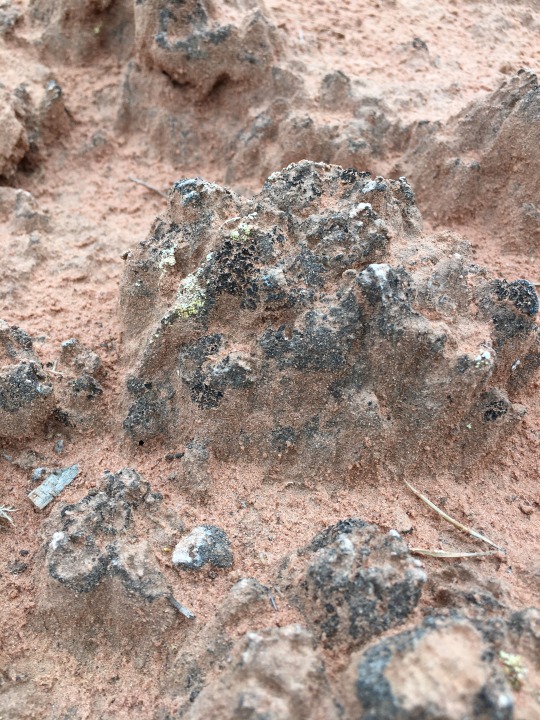
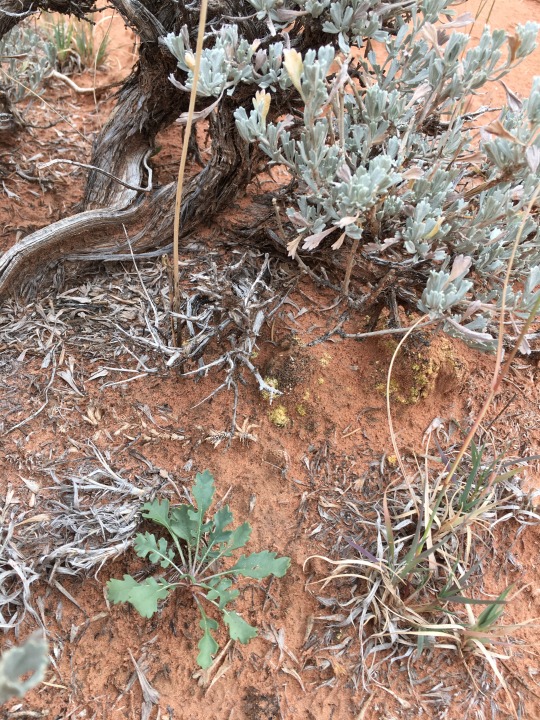


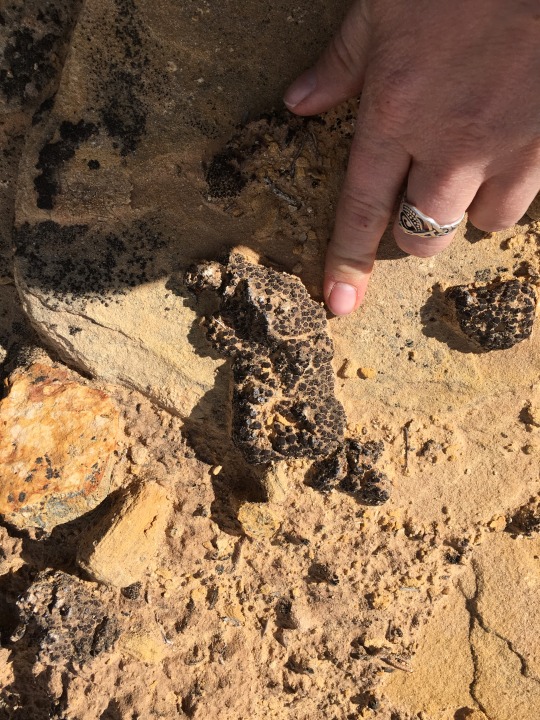
anyway OUR HEROS THE BIOCRUST aren't just there to look pretty (though you will can see from photos they also do this :) ), but are a vital component to the dryland ecosystem! They literally hold the soil surface together to prevent erosion, they influence hydrology in terms of rainfall runoff + infiltration, they impact how seeds germinate, they contribute to nutrient cycling and what plant-available compounds are held at the soil surface... like i feel like Tumblr in general has been made aware of how fungi & root networks interact in large scale systems like forests, but that is also happening on a more microscopic level in deserts! just in the top couple centimeters soooo much is happening. Cyanobacteria in particular are tiny organisms that produce little nets of sugars woven in the soil to climb around on and protect themselves, and if you crumble a little bit of soil from the surface you can see how the little spiderweb strings literally hold together the sand particles.
Now that you're Aware of biocrusts, when you look at larger scale landscape photos taken in un-trampled areas of desert, you will notice them as darker patches and textures on the lighter soil:


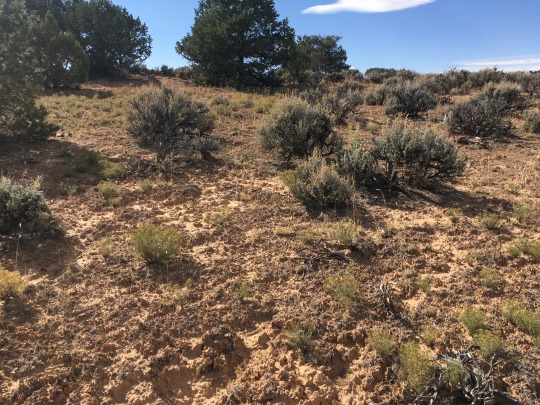
Yep there's these tiny little communities all over, that many people never learn to see. And now what I said before about mosses & cyanobacteria usually preferring wet environments--they have in fact adapted to life in the desert in ways that means they're dormant for most of the year. They live in stasis until the rainy season hits (or in some cases, winter moisture from a snow layer--many will photosynthesize through a few inches of snow since it's clear/white), and then burst into color and life. Many patches of biocrust will look utterly lifeless and dried out at first and then become vibrant and swell up within a few minutes of being exposed to moisture. Lichens, while more vibrant even when dry, will also mostly only grow/reproduce while wet. And biocrusts come in all sorts of colors, shapes, and preferred microhabitats!

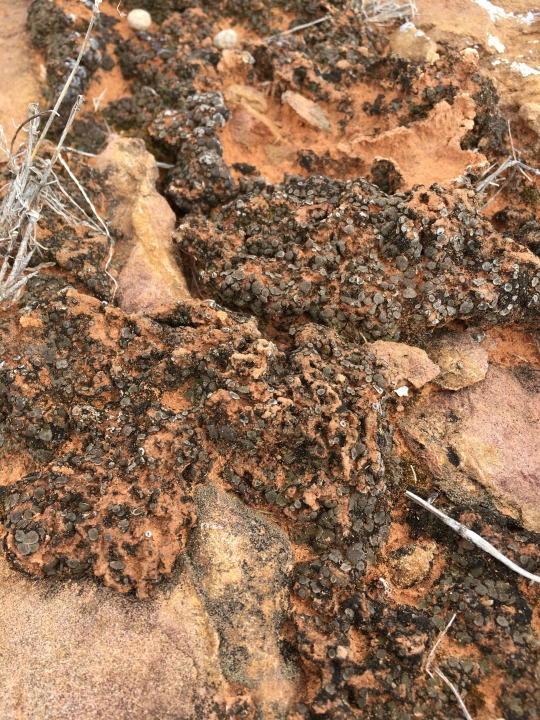
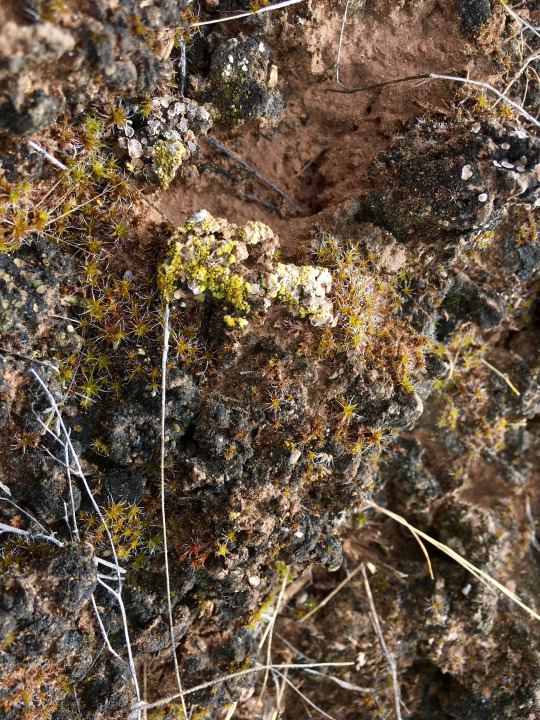

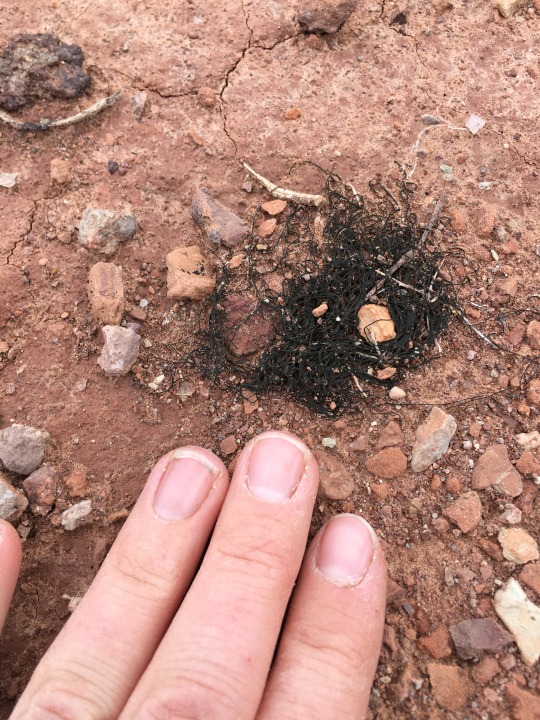
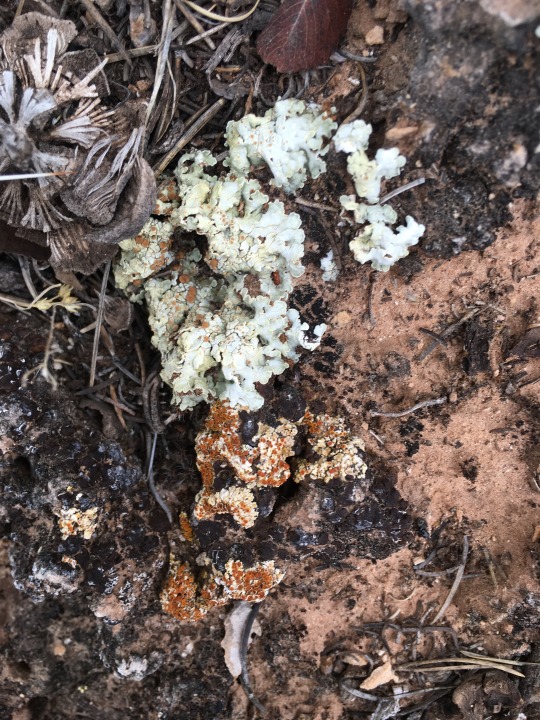

anyway this post is long enough already so i'll be quick. while beautiful and important as you can imagine these are FRAGILE. if they get trampled too much, by humans or cows or cars, that's it. you're back to bare soil that can blow away whenever it wants.
I was lucky to get to participate in a 2x/year survey of one of the very few places in Utah to NEVER have cattle grazing or development, a remote area the entrance is kept secret to inside Canyonlands National Park, where you can see just how dense and lush biocrusts once could be in the US southwest:

ah... glorious. what special little guys. this is why if you visit many of the national parks in Utah you will see signs & stickers around with slogans like "Don't Bust The Crust" and "Tiptoe Through The Crypto" and etc. so heed that advice but DO stop and kneel down and get a better look at them!
#LONG POST#if you dont like long posts you can turn on the collapse posts feature in settings fun fact dont yell at me for your own dash choices#deserts#desert southwest#biocrusts#biological soil crusts#now if i could get myself onto a videogame design team you'd bet id put THESE in those desert regions#its fantasy land give me beautiful fantasy biocrusts... so sad to see them all extinct in thedas how many druffalo did they graze... anyway#replies#ramblings#dreadfutures#i spent a beautiful weekend in monteray once. for a conference but i skipped a day to go to the aquarium and sea kayaking which was great#didnt get to go to the dunes but DID get to jump in the very cold ocean a bunch which is always a treat for a desert rat#all photos mine btw thats why theres no credits
60 notes
·
View notes
Text
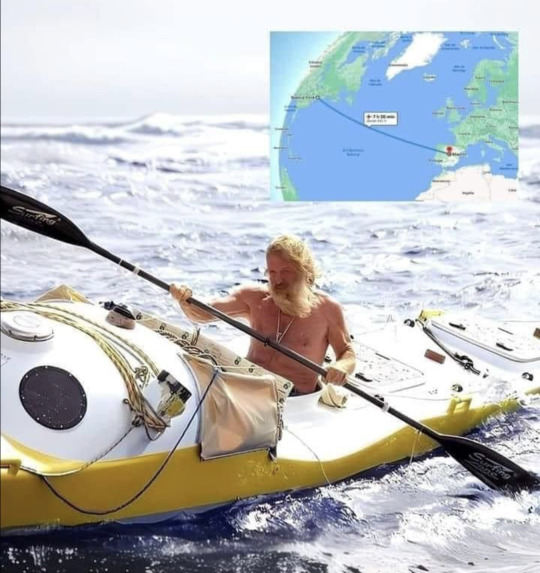
Aleksander Doba, a Polish adventurer, was the first person to "row" the Atlantic from Europe to New York, completely alone and without assistance. In 2017, at age 70, he kayaked 5,000 miles from the port of Le Conquet, France, to the shores of New York, braving storms, strong currents and the loneliness of the ocean for 110 days. His feat demonstrated an astonishing level of physical and mental endurance, inspiring generations of adventurers. Prior to this last kayaking expedition Doba won the gold medal at the Open Academic Polish Championships in Whitewater Kayaking when he was 57 years old and defended the title the following year.
Doba died while climbing Kilimanjaro on February 22, 2021. According to eyewitness reports he felt well the entire journey but after reaching the top asked for a two-minute break before posing for a photo. He then sat down on a rock and "just fell asleep". He was 74 years old.
#adventuring#adventurers#row across Atlantic#Aleksander Doba#endurance#inspiration to others#solitary feat#110 days kayaking#kayak#rowing feats#France to USA#The Old Man and the Sea?#mountain climber#death on mountain top
69 notes
·
View notes
Text
The Aasivarluit [Inuit mythology]!

The oceans have fascinated humans for millennia. As such, it is no surprise that a great many cultures from around the world have their own stories about scary and dangerous creatures from beneath the waves. One such being is the ocean-spider, or Aasivarluit, a massive monster from Inuit mythology.
As the appellation ‘ocean-spider’ implies, the Aasivarluit resembles a spider, albeit an unnaturally large one. It is a dangerous, giant animal and it was known to prey on unsuspecting kayakers by waiting underneath the surface of the sea and then pouncing upwards when a suitable victim appeared. In the absence of human prey, the monster was known to hunt walruses and seals for sustenance.
It doesn’t appear to be a common creature in Inuit mythology, in fact, all references I could find only mention one single story about the Aasivarluit:
A man was kayaking near the coast of Nuuk, the capital of Greenland (although it was called Godthåb back then). Suddenly he saw a massive object beneath the waves, which confused him greatly because he was familiar with this location and he knew that there was no shoal nearby. He then remembered stories about giant aquatic spiders, and quickly deduced that this must be the thing that suddenly appeared beneath his kayak. Indeed, he looked down into the water and saw a giant eye.
But the man was a skilled kayaker and he managed to get away safely. It is said that a less experienced kayaker would certainly have perished in his situation.
The idea of a giant oceanic spider that eats people might have originated as a cautionary tale (as in, don’t venture too far from the coast or the giant spider will eat you). While stories about giant animals are not uncommon in Inuit culture, the Aasivarluit is certainly a rather strange monster, considering that there are no marine spiders in real life (although there are freshwater spiders). Technically, sea spiders do exist, but they are spiders in name only: they belong to the class Pycnogonida whereas real spiders are Arachnida. They only share a vague resemblance (though there are some really pretty and weird sea spiders out there, I recommend googling them).
Sources: Rink, H., 1974, Tales and Traditions of the Eskimo, Montreal, McGill-Queen’s University Press, first published 1875, 473 pp, p. 471. Christopher, N., 2013, The Hidden: a compendium of arctic giants, dwarves, gnomes, trolls, faeries, and other strange beings from Inuit oral history, 191 pp, p. 134-135. (image source: @another_maker on Instagram)
#monsters#sea monsters#aquatic creatures#Inuit mythology#bestiary#mythical creatures#creatures#giant spiders#spiders#mythology#seriously there are some really cool Pycnogonida out there#They don't eat kayakers though#at least not that I know of
91 notes
·
View notes
Text
Water puppy 🥺
— source
#animals#cute#wholesome#sea puppy#sea puppies#kayaking#outdoors#activity#activities#ocean#lake#river#sea life#positivity#humor#funny#comedy#kindness
41 notes
·
View notes
Text
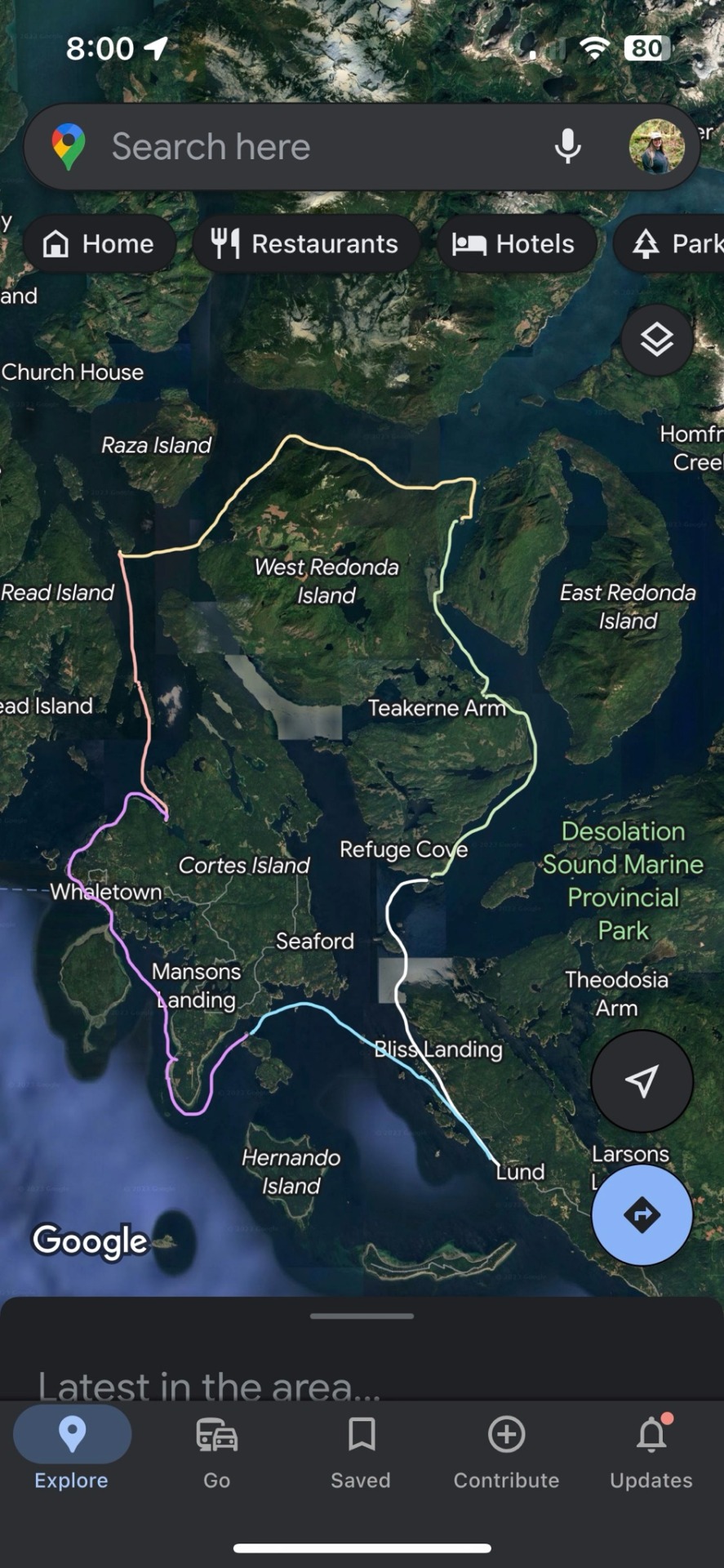



Kayak trip part 3: the route
This trip was a 6 day/5 night course launching from Lund and going counter clockwise around West Redonda and Cortes. On the map I used different colours for different days.
Day 1: Lund to Refuge Cove. My arms were absolutely killing as I got used to the paddling technique, and I was exhausted by end of day. The weather was misty and windy which made the trip seem incredibly daunting.
Day 2: Refuge Cove to Walsh Cove. This day was sunny and my strength was back, and the site was beautiful. Camping on tiny islands and storing food in the boats meant wildlife was near-zero concern. It was a good day to go for a cold dip.
Day 3: Walsh Cove to Rendezvous Island South. This was the worst day for everyone else. The weather was downpour and the water was rough. But, we got to pass Toba Inlet which was amazing. On this trip was me and my partner, and our guide (a dear friend of ours) and his girlfriend.
Day 4: Rendezvous Island South to Carrington Bay. This was a short, sunny day with the wind on our backs. We even got to sail a bit with a tarp. The lagoon we stayed at is near the rave site on Cortes. This was the best beach for a dip. This is also where our guides girlfriend drunkenly told me about her affair and bullied my boyfriend.
Day 5: Carrington Bay to the Twin Islands. This was a 27km paddle in the heat. When there's no wind it feels like paddling in molasses. We passed Whaletown and Plunger Passage and saw a humpback in the distance. We got cell service again in this area, and timed the tide right to stop at Sharkspit for lunch. The most welcome part of this day was going around Smelt Bay Provincial Park and using a toilet and sink.
Day 6: Twin Islands back to Lund. The last day was bittersweet. We stopped at North Copeland for lunch, same as we did the first day, except this time I was much more confident steering and getting out on my own. We used double kayaks so we had twice the power, but we lagged behind our guide and his girlfriend since his paddling was way more efficient than ours. It's always a bummer to end a trip, but nice to get away from the girlfriend.
We spent a few days in Powell River afterward to see the salmon run and to shop at Ikea in Vancouver before heading home
#british columbia#bc#canada#mountain#forest#mountains#pnw#ocean#sea kayak#kayaking#trip#adventure#camping#outdoors#sunset#backpacking
10 notes
·
View notes
Text

262 notes
·
View notes
Text


Kayak Camping in Catalina
#nature core#nature inspired#nature#camping#catalina island#california hiking#california dreaming#california#oceancore#ocean#ocean aesthetic#backpacking#kayaking#kayaklife#hiking#salt water#sea salt#cliffs#island life#island living#travel#out on the road#out-on-the-road#backpack#outdoors#get outside#beachlife#california beach#beaches#beach
14 notes
·
View notes
Text
#frozen#frozen waters#water#waves#ocean#sea#watercolor#lakes#river#lakescape#great lakes#canada#kayaking
114 notes
·
View notes
Text
Your daily dose of clear water mesmerisation 🌊!.
#Water#Sea#Ocean#Lake#Clear water#Kayak#life#downfall#downfalldestiny#حياة#magic destinations#magical world#magic moments#Calm#Magic#Breathe#Away
52 notes
·
View notes




